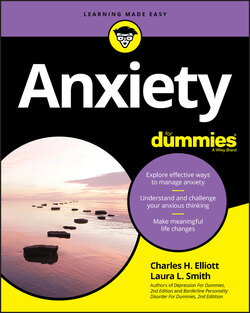Читать книгу Anxiety For Dummies - W. Doyle Gentry, Laura L. Smith - Страница 70
Following your fears
ОглавлениеOne of the best early steps that you can take to manage anxiety is to simply follow it every day in a couple of different ways. Why would you want to do that? After all, you already know full well that you’re anxious. Watching your worries is a good idea because it starts the process of change. You discover important patterns, triggers, and insights into your anxiety.
Observing anxiety fulfills several useful functions. First, monitoring forces you to be aware of your emotions. Avoiding and running away from troubling emotions only causes them to escalate. Second, you’ll see that your anxiety goes up and down throughout the day — which isn’t quite as upsetting as thinking it rules every moment of your life. And, you’re likely to discover that recording your ratings can help you take charge and feel more in control of what’s going on inside of you. Finally, keeping track helps you see how you’re progressing in your efforts to quell your distress.
Track your anxiety on your phone or in a notebook for a few weeks. Notice patterns or differences in intensity. Fill out your chart at the same time each day. On a scale of one to ten, ten being total panic and one being complete calm, rate the level of anxiety you experience around the same time in the morning, then again in the afternoon, and later in the evening. Virginia’s story shows you how tracking anxiety can be helpful.
Virginia complains to her friends that she’s the most nervous person on the planet and that she’s close to a nervous breakdown. Recently, her father had heart surgery, and her husband lost his job. Virginia feels completely out of control and says that her anxiety never stops. When her counselor suggests that she start tracking her anxiety, she tells him, “You’ve got to be kidding. I don’t need to do that. I can tell you right now that I’m anxious all the time. There’s no letup.” He urges her to go ahead and try anyway. Table 4-4 shows what Virginia comes up with in her first week of tracking.TABLE 4-4 Virginia’s Day-by-Day Anxiety LevelsDayMorningAfternoonEveningDaily AverageSunday4686Monday6797.3Tuesday5665.7Wednesday4575.3Thursday3886.3Friday5997.7Saturday3554.3Average4.36.67.46.1
Virginia discovers a few things. First, she notices that her anxiety is routinely less intense in the morning. It escalates in the afternoon and peaks in the evenings. With only one week’s record, she can’t discern whether her anxiety level is decreasing, increasing, or remaining stable. However, she notices feeling a little better simply because she feels like she’s starting to take charge of her problem. She also realizes that some days are better than others and that her anxiety varies rather than constantly overwhelming her.
